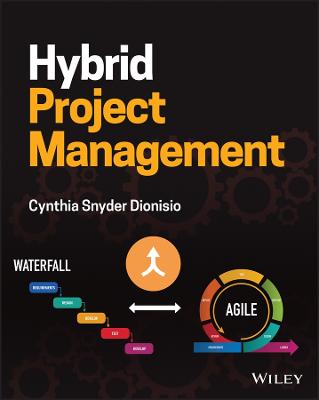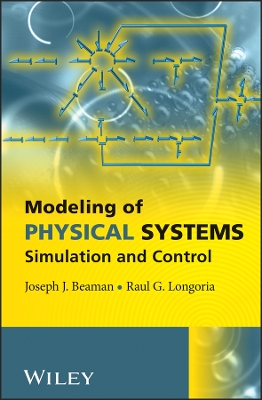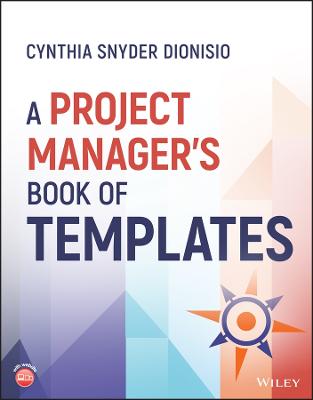Hybrid Project Management
 -15%
portes grátis
-15%
portes grátis
Hybrid Project Management
Snyder Dionisio, Cynthia
John Wiley & Sons Inc
12/2022
320
Mole
Inglês
9781119849728
15 a 20 dias
666
Descrição não disponível.
Acknowledgmentsxii
Introduction xiii
1 Introducing Project Management 1
The Spectrum of Development Approaches 2
Waterfall 3
Iterative 4
Incremental 6
Agile 8
Hybrid Project Management and Development Approaches 9
Summary 11
Key Terms 11
2 Choosing a Development Approach 12
Product Variables 12
Innovation 13
Scope Stability 13
Requirements Certainty 14
Ease of Change 14
Risk 15
Criticality 15
Safety 16
Regulatory 16
Project Variables 16
Stakeholders 17
Delivery Options 17
Funding Availability 18
Organization Variables 18
Structure 18
Culture 19
Project Team 19
Experience and Commitment 20
Development Approach Evaluation Tool 21
Product Variables 21
Project Variables 22
Organizational Variables 23
Creating a Visual Display of The Variables 24
Summary 25
Key Terms 25
3 Project Roles 26
Project Sponsor 26
Initiating Projects 27
Up- Front Planning 27
Monitoring Progress 28
Supporting the Project Manager 28
Project Manager 29
Leadership Skills 29
Management Skills 30
Product Owner 31
Product Functions 31
People Activities 32
Scrum Master 32
Facilitation 32
Support 33
The Team 33
Generalizing Specialists 34
Hybrid Options 35
Summary 36
Key Terms 36
4 Launching a Hybrid Project 37
Vision Statements 38
Organizations' Vision Statements 38
Project Vision Statements 39
Project Charter 40
Case Study 42
Background 42
Case Study Vision Statement 42
Case Study Charter 43
Assumptions and Constraints 46
Summary 47
Key Terms 47
5 Hybrid Project Planning and Structure 48
Planning Fundamentals 49
Progressive Elaboration and Rolling Wave Planning 49
Competing Demands 50
The Project Management Plan 51
Subsidiary Plans 51
Tailoring the Project Management Plan for Hybrid Projects 53
Project Life Cycles 54
Key Reviews 57
Project Management Plan for a Hybrid Project 58
Development Approach 58
Life Cycle 60
Subsidiary Plans 62
Key Reviews 63
Roadmap 63
Summary 64
Key Terms 65
6 Defining Scope in Hybrid Projects 66
Planning for Scope with a Scope Management Plan 66
Elaborating Scope with a Scope Statement 69
Narrative Description 69
Deliverables 70
Out of Scope 72
Organizing Scope with a Work Breakdown Structure 72
WBS Levels 72
Work Packages, Planning Packages, and Control Accounts 74
Steps to Create a WBS 76
Getting into the Detail with A WBS Dictionary 76
Working with Requirements 76
Elicitation 78
Prioritization 79
Documenting Requirements 81
Prioritizing Scope with a Backlog 83
Summary 84
Key Terms 84
7 Building a Predictive Schedule 85
Organizing with a Schedule Management Plan 85
Predictive Scheduling 88
Identify Tasks 88
Sequence Tasks 89
Assign Team Members 92
Estimate Durations 97
Summary 98
Key Terms 98
8 Analyzing and Finalizing a Predictive Schedule 100
Analyzing the Schedule 100
Convergence and Divergence 101
Resource Allocation 102
The Critical Path 104
Float 104
Finalizing the Schedule 106
Schedule Compression 106
Schedule Buffer 108
Baselining the Schedule 109
Summary 110
Key Terms 110
9 Adaptive and Hybrid Scheduling 111
Adaptive Scheduling 111
Release Planning 112
Task Boards 114
Hybrid Scheduling 115
Predictive with Releases and Iterations 115
Predictive with Iterations Inserted 116
Adaptive then Predictive 116
Dependencies in Hybrid Schedules 116
Summary 117
Key Terms 118
10 Estimating 119
Estimating Ranges 119
Estimating Methods 120
Analogous Estimating 121
Parametric Estimating 123
Multipoint Estimating 123
Uses and Benefits 124
Affinity Grouping 125
Wideband Delphi 127
Bottom- Up Estimating 128
Basis of Estimates 128
Estimating The Budget 129
Summary 131
Key Terms 132
11 Stakeholder Engagement 133
Identifying your Stakeholders 133
Analyzing Stakeholders 134
Grids and Matrixes 135
Analyzing Stakeholders by Role 137
Direction of Influence 137
Awareness and Support 137
Stakeholder Register 138
Planning for Successful Engagement 139
Planning Project Communication 140
Communication Methods 141
Communication Technology 141
Stakeholder Communication Plan 142
Summary 144
Key Terms 144
12 Maintaining Stakeholder Engagement 145
Engaging Stakeholders 145
Communication Competence 146
When Someone Is Speaking 147
When You Are Speaking 148
When You Are Writing 148
Feedback 149
Communication Blockers 150
Project Meetings 151
Adaptive Meetings 152
Predictive Meetings 156
Summary 157
Key Terms 157
13 Leadership in a Hybrid Environment 158
Emotional Intelligence 159
Self- Awareness 159
Self- Regulation 159
Social Awareness 160
Social Skills 160
Motivation 160
Motivators 161
Motivating Your Team 161
Example of Motivation in the Workplace 162
Agile Leadership Practices 162
Servant Leadership 162
Self- Managing Teams 163
Tailoring for a Hybrid Environment 166
Developing a High- Performing Team 166
Traits of High- Performing Teams 167
Building Relationships 167
Summary 168
Key Terms 168
14 Planning for Risk 169
Introduction to Risk Management 169
Risk Tolerance and Thresholds 171
Risk Management Plan 171
Elements in a Risk Management Plan 172
Sample Risk Management Plan 174
Risk Management Plan 174
Funding 175
Timing 175
Risk Categories 176
Definitions of Probability 176
Definitions of Impact 176
Probability and Impact Matrix 176
Summary 177
Key Terms 177
15 Identifying and Prioritizing Risk 178
Identifying Risks 178
Identification Methods 179
Documenting Risks 181
Analyzing and Prioritizing Risks 183
Filling out the Probability and Impact Matrix 183
Assessing Additional Risk Parameters 184
Simple Quantitative Analysis Methods 186
Expected Monetary Value 186
Decision Trees 187
Summary 188
Key Terms 188
16 Reducing Risk 189
Risk Responses 189
Risk Avoidance 190
Risk Mitigation 190
Risk Transference 190
Risk Escalation 191
Risk Acceptance 191
Implementing Responses 192
Risk- Adjusted Backlog 193
Reserve 195
Contingency Reserve 195
Management Reserve 199
Summary 199
Key Terms 200
17 Leading the Team 201
Establishing a Healthy Environment 201
Psychological Safety 202
Creating a Safe Environment 202
Cultivating Adaptability 203
Fostering Resilience 205
Ways of Thinking 205
Critical Thinking 206
Working with Bias 208
System Thinking 209
Supporting the Team 209
Solving Problems 210
Making Decisions 210
Resolving Conflicts 211
Considerations for Virtual Teams 213
Engagement 213
Structure 214
Virtual Meetings 215
Summary 216
Key Terms 216
18 Maintaining Momentum 217
Working with Change 217
Change Management Plan 218
Change Requests 219
Change Log 220
Requirements Traceability Matrix 221
Managing Change in a Hybrid Environment 221
Change for Predictive Deliverables 222
Change for Adaptive Deliverables 222
Helpful Tools 222
Decision Log 223
Issue Log 223
Impediment Log 224
Summary 224
Key Terms 224
19 Metrics for Predictive Deliverables 225
Predictive Measures 225
Schedule Measures 226
Cost Measures 228
Earned Value Management 231
Planning for Earned Value 231
Determining Earned Value and Actual Cost 236
Calculating Schedule and Cost Variances 237
Calculating Schedule and Cost Indexes 238
Forecasts 239
Estimate to Complete 240
Estimate at Completion 240
Summary 241
Key Terms 242
20 Metrics for Adaptive Deliverables 243
Adaptive Measures 243
Burndown Charts 244
Burnup Charts 246
Estimating Velocity 247
Cumulative Flow Diagrams 248
Creating a Cumulative Flow Diagram 250
Stakeholder Measures 253
Net Promoter Score (R) 253
Mood Chart 254
Summary 255
Key Terms 255
21 Reporting for Hybrid Projects 256
Reporting 256
Narrative Reports 257
Visual Reports 260
Dashboards 260
Information Radiators 270
Hybrid Dashboards 270
Tips 272
Benefits 272
Summary 272
Key Terms 272
22 Corrective Actions and Closure 273
Preventive and Corrective Actions 273
Potential Causes and Responses for Performance Issues 274
Updating the Baseline 276
Project Closure 276
Transition 277
Administrative Closure 277
Acknowledgment 277
Evaluating Success 278
Close- Out Reports 278
Summary 280
Key Terms 280
23 Making the Move to a Hybrid Environment 281
Establish Criteria 281
Establish the Right Environment 282
Process First 282
Glossary 284
Index 292
Introduction xiii
1 Introducing Project Management 1
The Spectrum of Development Approaches 2
Waterfall 3
Iterative 4
Incremental 6
Agile 8
Hybrid Project Management and Development Approaches 9
Summary 11
Key Terms 11
2 Choosing a Development Approach 12
Product Variables 12
Innovation 13
Scope Stability 13
Requirements Certainty 14
Ease of Change 14
Risk 15
Criticality 15
Safety 16
Regulatory 16
Project Variables 16
Stakeholders 17
Delivery Options 17
Funding Availability 18
Organization Variables 18
Structure 18
Culture 19
Project Team 19
Experience and Commitment 20
Development Approach Evaluation Tool 21
Product Variables 21
Project Variables 22
Organizational Variables 23
Creating a Visual Display of The Variables 24
Summary 25
Key Terms 25
3 Project Roles 26
Project Sponsor 26
Initiating Projects 27
Up- Front Planning 27
Monitoring Progress 28
Supporting the Project Manager 28
Project Manager 29
Leadership Skills 29
Management Skills 30
Product Owner 31
Product Functions 31
People Activities 32
Scrum Master 32
Facilitation 32
Support 33
The Team 33
Generalizing Specialists 34
Hybrid Options 35
Summary 36
Key Terms 36
4 Launching a Hybrid Project 37
Vision Statements 38
Organizations' Vision Statements 38
Project Vision Statements 39
Project Charter 40
Case Study 42
Background 42
Case Study Vision Statement 42
Case Study Charter 43
Assumptions and Constraints 46
Summary 47
Key Terms 47
5 Hybrid Project Planning and Structure 48
Planning Fundamentals 49
Progressive Elaboration and Rolling Wave Planning 49
Competing Demands 50
The Project Management Plan 51
Subsidiary Plans 51
Tailoring the Project Management Plan for Hybrid Projects 53
Project Life Cycles 54
Key Reviews 57
Project Management Plan for a Hybrid Project 58
Development Approach 58
Life Cycle 60
Subsidiary Plans 62
Key Reviews 63
Roadmap 63
Summary 64
Key Terms 65
6 Defining Scope in Hybrid Projects 66
Planning for Scope with a Scope Management Plan 66
Elaborating Scope with a Scope Statement 69
Narrative Description 69
Deliverables 70
Out of Scope 72
Organizing Scope with a Work Breakdown Structure 72
WBS Levels 72
Work Packages, Planning Packages, and Control Accounts 74
Steps to Create a WBS 76
Getting into the Detail with A WBS Dictionary 76
Working with Requirements 76
Elicitation 78
Prioritization 79
Documenting Requirements 81
Prioritizing Scope with a Backlog 83
Summary 84
Key Terms 84
7 Building a Predictive Schedule 85
Organizing with a Schedule Management Plan 85
Predictive Scheduling 88
Identify Tasks 88
Sequence Tasks 89
Assign Team Members 92
Estimate Durations 97
Summary 98
Key Terms 98
8 Analyzing and Finalizing a Predictive Schedule 100
Analyzing the Schedule 100
Convergence and Divergence 101
Resource Allocation 102
The Critical Path 104
Float 104
Finalizing the Schedule 106
Schedule Compression 106
Schedule Buffer 108
Baselining the Schedule 109
Summary 110
Key Terms 110
9 Adaptive and Hybrid Scheduling 111
Adaptive Scheduling 111
Release Planning 112
Task Boards 114
Hybrid Scheduling 115
Predictive with Releases and Iterations 115
Predictive with Iterations Inserted 116
Adaptive then Predictive 116
Dependencies in Hybrid Schedules 116
Summary 117
Key Terms 118
10 Estimating 119
Estimating Ranges 119
Estimating Methods 120
Analogous Estimating 121
Parametric Estimating 123
Multipoint Estimating 123
Uses and Benefits 124
Affinity Grouping 125
Wideband Delphi 127
Bottom- Up Estimating 128
Basis of Estimates 128
Estimating The Budget 129
Summary 131
Key Terms 132
11 Stakeholder Engagement 133
Identifying your Stakeholders 133
Analyzing Stakeholders 134
Grids and Matrixes 135
Analyzing Stakeholders by Role 137
Direction of Influence 137
Awareness and Support 137
Stakeholder Register 138
Planning for Successful Engagement 139
Planning Project Communication 140
Communication Methods 141
Communication Technology 141
Stakeholder Communication Plan 142
Summary 144
Key Terms 144
12 Maintaining Stakeholder Engagement 145
Engaging Stakeholders 145
Communication Competence 146
When Someone Is Speaking 147
When You Are Speaking 148
When You Are Writing 148
Feedback 149
Communication Blockers 150
Project Meetings 151
Adaptive Meetings 152
Predictive Meetings 156
Summary 157
Key Terms 157
13 Leadership in a Hybrid Environment 158
Emotional Intelligence 159
Self- Awareness 159
Self- Regulation 159
Social Awareness 160
Social Skills 160
Motivation 160
Motivators 161
Motivating Your Team 161
Example of Motivation in the Workplace 162
Agile Leadership Practices 162
Servant Leadership 162
Self- Managing Teams 163
Tailoring for a Hybrid Environment 166
Developing a High- Performing Team 166
Traits of High- Performing Teams 167
Building Relationships 167
Summary 168
Key Terms 168
14 Planning for Risk 169
Introduction to Risk Management 169
Risk Tolerance and Thresholds 171
Risk Management Plan 171
Elements in a Risk Management Plan 172
Sample Risk Management Plan 174
Risk Management Plan 174
Funding 175
Timing 175
Risk Categories 176
Definitions of Probability 176
Definitions of Impact 176
Probability and Impact Matrix 176
Summary 177
Key Terms 177
15 Identifying and Prioritizing Risk 178
Identifying Risks 178
Identification Methods 179
Documenting Risks 181
Analyzing and Prioritizing Risks 183
Filling out the Probability and Impact Matrix 183
Assessing Additional Risk Parameters 184
Simple Quantitative Analysis Methods 186
Expected Monetary Value 186
Decision Trees 187
Summary 188
Key Terms 188
16 Reducing Risk 189
Risk Responses 189
Risk Avoidance 190
Risk Mitigation 190
Risk Transference 190
Risk Escalation 191
Risk Acceptance 191
Implementing Responses 192
Risk- Adjusted Backlog 193
Reserve 195
Contingency Reserve 195
Management Reserve 199
Summary 199
Key Terms 200
17 Leading the Team 201
Establishing a Healthy Environment 201
Psychological Safety 202
Creating a Safe Environment 202
Cultivating Adaptability 203
Fostering Resilience 205
Ways of Thinking 205
Critical Thinking 206
Working with Bias 208
System Thinking 209
Supporting the Team 209
Solving Problems 210
Making Decisions 210
Resolving Conflicts 211
Considerations for Virtual Teams 213
Engagement 213
Structure 214
Virtual Meetings 215
Summary 216
Key Terms 216
18 Maintaining Momentum 217
Working with Change 217
Change Management Plan 218
Change Requests 219
Change Log 220
Requirements Traceability Matrix 221
Managing Change in a Hybrid Environment 221
Change for Predictive Deliverables 222
Change for Adaptive Deliverables 222
Helpful Tools 222
Decision Log 223
Issue Log 223
Impediment Log 224
Summary 224
Key Terms 224
19 Metrics for Predictive Deliverables 225
Predictive Measures 225
Schedule Measures 226
Cost Measures 228
Earned Value Management 231
Planning for Earned Value 231
Determining Earned Value and Actual Cost 236
Calculating Schedule and Cost Variances 237
Calculating Schedule and Cost Indexes 238
Forecasts 239
Estimate to Complete 240
Estimate at Completion 240
Summary 241
Key Terms 242
20 Metrics for Adaptive Deliverables 243
Adaptive Measures 243
Burndown Charts 244
Burnup Charts 246
Estimating Velocity 247
Cumulative Flow Diagrams 248
Creating a Cumulative Flow Diagram 250
Stakeholder Measures 253
Net Promoter Score (R) 253
Mood Chart 254
Summary 255
Key Terms 255
21 Reporting for Hybrid Projects 256
Reporting 256
Narrative Reports 257
Visual Reports 260
Dashboards 260
Information Radiators 270
Hybrid Dashboards 270
Tips 272
Benefits 272
Summary 272
Key Terms 272
22 Corrective Actions and Closure 273
Preventive and Corrective Actions 273
Potential Causes and Responses for Performance Issues 274
Updating the Baseline 276
Project Closure 276
Transition 277
Administrative Closure 277
Acknowledgment 277
Evaluating Success 278
Close- Out Reports 278
Summary 280
Key Terms 280
23 Making the Move to a Hybrid Environment 281
Establish Criteria 281
Establish the Right Environment 282
Process First 282
Glossary 284
Index 292
Este título pertence ao(s) assunto(s) indicados(s). Para ver outros títulos clique no assunto desejado.
project management; waterfall project management; agile project management; adaptive project management; project management; project stakeholders; hybrid projects; project management methods; project management approaches
Acknowledgmentsxii
Introduction xiii
1 Introducing Project Management 1
The Spectrum of Development Approaches 2
Waterfall 3
Iterative 4
Incremental 6
Agile 8
Hybrid Project Management and Development Approaches 9
Summary 11
Key Terms 11
2 Choosing a Development Approach 12
Product Variables 12
Innovation 13
Scope Stability 13
Requirements Certainty 14
Ease of Change 14
Risk 15
Criticality 15
Safety 16
Regulatory 16
Project Variables 16
Stakeholders 17
Delivery Options 17
Funding Availability 18
Organization Variables 18
Structure 18
Culture 19
Project Team 19
Experience and Commitment 20
Development Approach Evaluation Tool 21
Product Variables 21
Project Variables 22
Organizational Variables 23
Creating a Visual Display of The Variables 24
Summary 25
Key Terms 25
3 Project Roles 26
Project Sponsor 26
Initiating Projects 27
Up- Front Planning 27
Monitoring Progress 28
Supporting the Project Manager 28
Project Manager 29
Leadership Skills 29
Management Skills 30
Product Owner 31
Product Functions 31
People Activities 32
Scrum Master 32
Facilitation 32
Support 33
The Team 33
Generalizing Specialists 34
Hybrid Options 35
Summary 36
Key Terms 36
4 Launching a Hybrid Project 37
Vision Statements 38
Organizations' Vision Statements 38
Project Vision Statements 39
Project Charter 40
Case Study 42
Background 42
Case Study Vision Statement 42
Case Study Charter 43
Assumptions and Constraints 46
Summary 47
Key Terms 47
5 Hybrid Project Planning and Structure 48
Planning Fundamentals 49
Progressive Elaboration and Rolling Wave Planning 49
Competing Demands 50
The Project Management Plan 51
Subsidiary Plans 51
Tailoring the Project Management Plan for Hybrid Projects 53
Project Life Cycles 54
Key Reviews 57
Project Management Plan for a Hybrid Project 58
Development Approach 58
Life Cycle 60
Subsidiary Plans 62
Key Reviews 63
Roadmap 63
Summary 64
Key Terms 65
6 Defining Scope in Hybrid Projects 66
Planning for Scope with a Scope Management Plan 66
Elaborating Scope with a Scope Statement 69
Narrative Description 69
Deliverables 70
Out of Scope 72
Organizing Scope with a Work Breakdown Structure 72
WBS Levels 72
Work Packages, Planning Packages, and Control Accounts 74
Steps to Create a WBS 76
Getting into the Detail with A WBS Dictionary 76
Working with Requirements 76
Elicitation 78
Prioritization 79
Documenting Requirements 81
Prioritizing Scope with a Backlog 83
Summary 84
Key Terms 84
7 Building a Predictive Schedule 85
Organizing with a Schedule Management Plan 85
Predictive Scheduling 88
Identify Tasks 88
Sequence Tasks 89
Assign Team Members 92
Estimate Durations 97
Summary 98
Key Terms 98
8 Analyzing and Finalizing a Predictive Schedule 100
Analyzing the Schedule 100
Convergence and Divergence 101
Resource Allocation 102
The Critical Path 104
Float 104
Finalizing the Schedule 106
Schedule Compression 106
Schedule Buffer 108
Baselining the Schedule 109
Summary 110
Key Terms 110
9 Adaptive and Hybrid Scheduling 111
Adaptive Scheduling 111
Release Planning 112
Task Boards 114
Hybrid Scheduling 115
Predictive with Releases and Iterations 115
Predictive with Iterations Inserted 116
Adaptive then Predictive 116
Dependencies in Hybrid Schedules 116
Summary 117
Key Terms 118
10 Estimating 119
Estimating Ranges 119
Estimating Methods 120
Analogous Estimating 121
Parametric Estimating 123
Multipoint Estimating 123
Uses and Benefits 124
Affinity Grouping 125
Wideband Delphi 127
Bottom- Up Estimating 128
Basis of Estimates 128
Estimating The Budget 129
Summary 131
Key Terms 132
11 Stakeholder Engagement 133
Identifying your Stakeholders 133
Analyzing Stakeholders 134
Grids and Matrixes 135
Analyzing Stakeholders by Role 137
Direction of Influence 137
Awareness and Support 137
Stakeholder Register 138
Planning for Successful Engagement 139
Planning Project Communication 140
Communication Methods 141
Communication Technology 141
Stakeholder Communication Plan 142
Summary 144
Key Terms 144
12 Maintaining Stakeholder Engagement 145
Engaging Stakeholders 145
Communication Competence 146
When Someone Is Speaking 147
When You Are Speaking 148
When You Are Writing 148
Feedback 149
Communication Blockers 150
Project Meetings 151
Adaptive Meetings 152
Predictive Meetings 156
Summary 157
Key Terms 157
13 Leadership in a Hybrid Environment 158
Emotional Intelligence 159
Self- Awareness 159
Self- Regulation 159
Social Awareness 160
Social Skills 160
Motivation 160
Motivators 161
Motivating Your Team 161
Example of Motivation in the Workplace 162
Agile Leadership Practices 162
Servant Leadership 162
Self- Managing Teams 163
Tailoring for a Hybrid Environment 166
Developing a High- Performing Team 166
Traits of High- Performing Teams 167
Building Relationships 167
Summary 168
Key Terms 168
14 Planning for Risk 169
Introduction to Risk Management 169
Risk Tolerance and Thresholds 171
Risk Management Plan 171
Elements in a Risk Management Plan 172
Sample Risk Management Plan 174
Risk Management Plan 174
Funding 175
Timing 175
Risk Categories 176
Definitions of Probability 176
Definitions of Impact 176
Probability and Impact Matrix 176
Summary 177
Key Terms 177
15 Identifying and Prioritizing Risk 178
Identifying Risks 178
Identification Methods 179
Documenting Risks 181
Analyzing and Prioritizing Risks 183
Filling out the Probability and Impact Matrix 183
Assessing Additional Risk Parameters 184
Simple Quantitative Analysis Methods 186
Expected Monetary Value 186
Decision Trees 187
Summary 188
Key Terms 188
16 Reducing Risk 189
Risk Responses 189
Risk Avoidance 190
Risk Mitigation 190
Risk Transference 190
Risk Escalation 191
Risk Acceptance 191
Implementing Responses 192
Risk- Adjusted Backlog 193
Reserve 195
Contingency Reserve 195
Management Reserve 199
Summary 199
Key Terms 200
17 Leading the Team 201
Establishing a Healthy Environment 201
Psychological Safety 202
Creating a Safe Environment 202
Cultivating Adaptability 203
Fostering Resilience 205
Ways of Thinking 205
Critical Thinking 206
Working with Bias 208
System Thinking 209
Supporting the Team 209
Solving Problems 210
Making Decisions 210
Resolving Conflicts 211
Considerations for Virtual Teams 213
Engagement 213
Structure 214
Virtual Meetings 215
Summary 216
Key Terms 216
18 Maintaining Momentum 217
Working with Change 217
Change Management Plan 218
Change Requests 219
Change Log 220
Requirements Traceability Matrix 221
Managing Change in a Hybrid Environment 221
Change for Predictive Deliverables 222
Change for Adaptive Deliverables 222
Helpful Tools 222
Decision Log 223
Issue Log 223
Impediment Log 224
Summary 224
Key Terms 224
19 Metrics for Predictive Deliverables 225
Predictive Measures 225
Schedule Measures 226
Cost Measures 228
Earned Value Management 231
Planning for Earned Value 231
Determining Earned Value and Actual Cost 236
Calculating Schedule and Cost Variances 237
Calculating Schedule and Cost Indexes 238
Forecasts 239
Estimate to Complete 240
Estimate at Completion 240
Summary 241
Key Terms 242
20 Metrics for Adaptive Deliverables 243
Adaptive Measures 243
Burndown Charts 244
Burnup Charts 246
Estimating Velocity 247
Cumulative Flow Diagrams 248
Creating a Cumulative Flow Diagram 250
Stakeholder Measures 253
Net Promoter Score (R) 253
Mood Chart 254
Summary 255
Key Terms 255
21 Reporting for Hybrid Projects 256
Reporting 256
Narrative Reports 257
Visual Reports 260
Dashboards 260
Information Radiators 270
Hybrid Dashboards 270
Tips 272
Benefits 272
Summary 272
Key Terms 272
22 Corrective Actions and Closure 273
Preventive and Corrective Actions 273
Potential Causes and Responses for Performance Issues 274
Updating the Baseline 276
Project Closure 276
Transition 277
Administrative Closure 277
Acknowledgment 277
Evaluating Success 278
Close- Out Reports 278
Summary 280
Key Terms 280
23 Making the Move to a Hybrid Environment 281
Establish Criteria 281
Establish the Right Environment 282
Process First 282
Glossary 284
Index 292
Introduction xiii
1 Introducing Project Management 1
The Spectrum of Development Approaches 2
Waterfall 3
Iterative 4
Incremental 6
Agile 8
Hybrid Project Management and Development Approaches 9
Summary 11
Key Terms 11
2 Choosing a Development Approach 12
Product Variables 12
Innovation 13
Scope Stability 13
Requirements Certainty 14
Ease of Change 14
Risk 15
Criticality 15
Safety 16
Regulatory 16
Project Variables 16
Stakeholders 17
Delivery Options 17
Funding Availability 18
Organization Variables 18
Structure 18
Culture 19
Project Team 19
Experience and Commitment 20
Development Approach Evaluation Tool 21
Product Variables 21
Project Variables 22
Organizational Variables 23
Creating a Visual Display of The Variables 24
Summary 25
Key Terms 25
3 Project Roles 26
Project Sponsor 26
Initiating Projects 27
Up- Front Planning 27
Monitoring Progress 28
Supporting the Project Manager 28
Project Manager 29
Leadership Skills 29
Management Skills 30
Product Owner 31
Product Functions 31
People Activities 32
Scrum Master 32
Facilitation 32
Support 33
The Team 33
Generalizing Specialists 34
Hybrid Options 35
Summary 36
Key Terms 36
4 Launching a Hybrid Project 37
Vision Statements 38
Organizations' Vision Statements 38
Project Vision Statements 39
Project Charter 40
Case Study 42
Background 42
Case Study Vision Statement 42
Case Study Charter 43
Assumptions and Constraints 46
Summary 47
Key Terms 47
5 Hybrid Project Planning and Structure 48
Planning Fundamentals 49
Progressive Elaboration and Rolling Wave Planning 49
Competing Demands 50
The Project Management Plan 51
Subsidiary Plans 51
Tailoring the Project Management Plan for Hybrid Projects 53
Project Life Cycles 54
Key Reviews 57
Project Management Plan for a Hybrid Project 58
Development Approach 58
Life Cycle 60
Subsidiary Plans 62
Key Reviews 63
Roadmap 63
Summary 64
Key Terms 65
6 Defining Scope in Hybrid Projects 66
Planning for Scope with a Scope Management Plan 66
Elaborating Scope with a Scope Statement 69
Narrative Description 69
Deliverables 70
Out of Scope 72
Organizing Scope with a Work Breakdown Structure 72
WBS Levels 72
Work Packages, Planning Packages, and Control Accounts 74
Steps to Create a WBS 76
Getting into the Detail with A WBS Dictionary 76
Working with Requirements 76
Elicitation 78
Prioritization 79
Documenting Requirements 81
Prioritizing Scope with a Backlog 83
Summary 84
Key Terms 84
7 Building a Predictive Schedule 85
Organizing with a Schedule Management Plan 85
Predictive Scheduling 88
Identify Tasks 88
Sequence Tasks 89
Assign Team Members 92
Estimate Durations 97
Summary 98
Key Terms 98
8 Analyzing and Finalizing a Predictive Schedule 100
Analyzing the Schedule 100
Convergence and Divergence 101
Resource Allocation 102
The Critical Path 104
Float 104
Finalizing the Schedule 106
Schedule Compression 106
Schedule Buffer 108
Baselining the Schedule 109
Summary 110
Key Terms 110
9 Adaptive and Hybrid Scheduling 111
Adaptive Scheduling 111
Release Planning 112
Task Boards 114
Hybrid Scheduling 115
Predictive with Releases and Iterations 115
Predictive with Iterations Inserted 116
Adaptive then Predictive 116
Dependencies in Hybrid Schedules 116
Summary 117
Key Terms 118
10 Estimating 119
Estimating Ranges 119
Estimating Methods 120
Analogous Estimating 121
Parametric Estimating 123
Multipoint Estimating 123
Uses and Benefits 124
Affinity Grouping 125
Wideband Delphi 127
Bottom- Up Estimating 128
Basis of Estimates 128
Estimating The Budget 129
Summary 131
Key Terms 132
11 Stakeholder Engagement 133
Identifying your Stakeholders 133
Analyzing Stakeholders 134
Grids and Matrixes 135
Analyzing Stakeholders by Role 137
Direction of Influence 137
Awareness and Support 137
Stakeholder Register 138
Planning for Successful Engagement 139
Planning Project Communication 140
Communication Methods 141
Communication Technology 141
Stakeholder Communication Plan 142
Summary 144
Key Terms 144
12 Maintaining Stakeholder Engagement 145
Engaging Stakeholders 145
Communication Competence 146
When Someone Is Speaking 147
When You Are Speaking 148
When You Are Writing 148
Feedback 149
Communication Blockers 150
Project Meetings 151
Adaptive Meetings 152
Predictive Meetings 156
Summary 157
Key Terms 157
13 Leadership in a Hybrid Environment 158
Emotional Intelligence 159
Self- Awareness 159
Self- Regulation 159
Social Awareness 160
Social Skills 160
Motivation 160
Motivators 161
Motivating Your Team 161
Example of Motivation in the Workplace 162
Agile Leadership Practices 162
Servant Leadership 162
Self- Managing Teams 163
Tailoring for a Hybrid Environment 166
Developing a High- Performing Team 166
Traits of High- Performing Teams 167
Building Relationships 167
Summary 168
Key Terms 168
14 Planning for Risk 169
Introduction to Risk Management 169
Risk Tolerance and Thresholds 171
Risk Management Plan 171
Elements in a Risk Management Plan 172
Sample Risk Management Plan 174
Risk Management Plan 174
Funding 175
Timing 175
Risk Categories 176
Definitions of Probability 176
Definitions of Impact 176
Probability and Impact Matrix 176
Summary 177
Key Terms 177
15 Identifying and Prioritizing Risk 178
Identifying Risks 178
Identification Methods 179
Documenting Risks 181
Analyzing and Prioritizing Risks 183
Filling out the Probability and Impact Matrix 183
Assessing Additional Risk Parameters 184
Simple Quantitative Analysis Methods 186
Expected Monetary Value 186
Decision Trees 187
Summary 188
Key Terms 188
16 Reducing Risk 189
Risk Responses 189
Risk Avoidance 190
Risk Mitigation 190
Risk Transference 190
Risk Escalation 191
Risk Acceptance 191
Implementing Responses 192
Risk- Adjusted Backlog 193
Reserve 195
Contingency Reserve 195
Management Reserve 199
Summary 199
Key Terms 200
17 Leading the Team 201
Establishing a Healthy Environment 201
Psychological Safety 202
Creating a Safe Environment 202
Cultivating Adaptability 203
Fostering Resilience 205
Ways of Thinking 205
Critical Thinking 206
Working with Bias 208
System Thinking 209
Supporting the Team 209
Solving Problems 210
Making Decisions 210
Resolving Conflicts 211
Considerations for Virtual Teams 213
Engagement 213
Structure 214
Virtual Meetings 215
Summary 216
Key Terms 216
18 Maintaining Momentum 217
Working with Change 217
Change Management Plan 218
Change Requests 219
Change Log 220
Requirements Traceability Matrix 221
Managing Change in a Hybrid Environment 221
Change for Predictive Deliverables 222
Change for Adaptive Deliverables 222
Helpful Tools 222
Decision Log 223
Issue Log 223
Impediment Log 224
Summary 224
Key Terms 224
19 Metrics for Predictive Deliverables 225
Predictive Measures 225
Schedule Measures 226
Cost Measures 228
Earned Value Management 231
Planning for Earned Value 231
Determining Earned Value and Actual Cost 236
Calculating Schedule and Cost Variances 237
Calculating Schedule and Cost Indexes 238
Forecasts 239
Estimate to Complete 240
Estimate at Completion 240
Summary 241
Key Terms 242
20 Metrics for Adaptive Deliverables 243
Adaptive Measures 243
Burndown Charts 244
Burnup Charts 246
Estimating Velocity 247
Cumulative Flow Diagrams 248
Creating a Cumulative Flow Diagram 250
Stakeholder Measures 253
Net Promoter Score (R) 253
Mood Chart 254
Summary 255
Key Terms 255
21 Reporting for Hybrid Projects 256
Reporting 256
Narrative Reports 257
Visual Reports 260
Dashboards 260
Information Radiators 270
Hybrid Dashboards 270
Tips 272
Benefits 272
Summary 272
Key Terms 272
22 Corrective Actions and Closure 273
Preventive and Corrective Actions 273
Potential Causes and Responses for Performance Issues 274
Updating the Baseline 276
Project Closure 276
Transition 277
Administrative Closure 277
Acknowledgment 277
Evaluating Success 278
Close- Out Reports 278
Summary 280
Key Terms 280
23 Making the Move to a Hybrid Environment 281
Establish Criteria 281
Establish the Right Environment 282
Process First 282
Glossary 284
Index 292
Este título pertence ao(s) assunto(s) indicados(s). Para ver outros títulos clique no assunto desejado.







